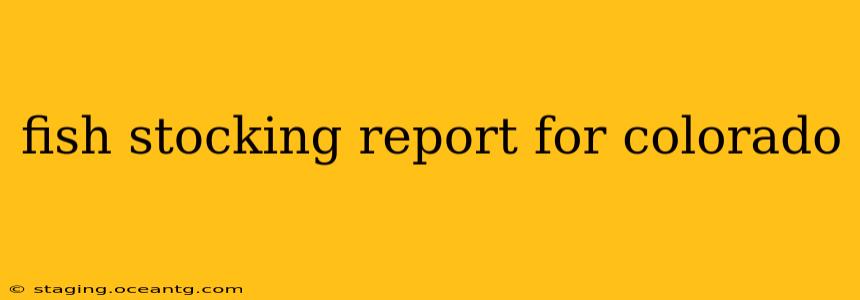Colorado boasts a vibrant network of rivers, lakes, and reservoirs, making it a haven for anglers. Understanding fish stocking reports is crucial for maximizing your fishing success. These reports, typically published by the Colorado Parks and Wildlife (CPW) agency, detail where and when fish are stocked, providing invaluable information for planning your fishing trips. This comprehensive guide explains everything you need to know about accessing and utilizing Colorado fish stocking reports.
Where to Find Colorado Fish Stocking Reports?
The primary source for Colorado fish stocking information is the official Colorado Parks and Wildlife (CPW) website. Navigate to their website and search for "stocking reports" or "fish stocking." You'll typically find a dedicated section or page with interactive maps, downloadable reports, and sometimes even a searchable database. The reports are usually updated regularly, often weekly or bi-weekly, so check back frequently for the most up-to-date information.
What Information is Included in the Reports?
Colorado's fish stocking reports usually include the following crucial details:
- Species: The type of fish stocked (e.g., rainbow trout, brown trout, kokanee salmon).
- Location: The specific water body where the fish were stocked (lake, river, reservoir name). Often, this will include more precise locations within a larger water body.
- Date: The date(s) when the stocking took place.
- Number of Fish: The approximate number of fish stocked, often categorized by size.
- Size of Fish: The average or range of sizes of the stocked fish (e.g., 8-10 inches).
This detailed information empowers anglers to target specific locations and species, significantly enhancing their chances of a successful fishing trip.
How to Use Colorado Fish Stocking Reports Effectively
Using the reports effectively requires more than just glancing at the data. Consider these strategies:
- Plan Your Trip: Use the reports to identify waters with recent stockings of your target species. This increases your odds of catching fish.
- Check the Timing: Understand that recently stocked fish might be easier to catch, as they haven't yet had time to disperse or become wary of anglers.
- Consider Water Conditions: Stocking reports don't always include water temperature or flow information. Check CPW's website for this additional information, as it greatly affects fish behavior and fishing success.
- Respect Regulations: Always abide by Colorado's fishing regulations, including size and bag limits, which can vary by water body and species.
What Types of Fish are Commonly Stocked in Colorado?
Colorado stocks a variety of fish species, depending on the water body's suitability. Some of the most common include:
- Rainbow Trout: A popular and widely stocked species, known for its vibrant colors and fighting ability.
- Brown Trout: A strong fighter often found in larger rivers and lakes.
- Cutthroat Trout: A native Colorado species, prized by anglers for its beauty and fighting spirit.
- Kokanee Salmon: A landlocked salmon species found in several Colorado reservoirs.
Are there different reports for different regions of Colorado?
While the CPW website presents a comprehensive overview, it's often organized by region or watershed. This makes it easier to focus your search on areas of interest to you. Look for regional filters or menus to narrow your search.
How often are the fish stocking reports updated?
The frequency of updates varies, but generally, you can expect updates at least weekly, sometimes more often during peak stocking seasons. Regularly checking the CPW website is recommended to stay current.
Can I get the reports delivered to me?
While there isn't typically a direct subscription service for email delivery of these reports, you can set up custom alerts or RSS feeds for the CPW website to be notified of updates. Check their website for these options.
By utilizing Colorado's fish stocking reports strategically and responsibly, you can elevate your angling experience and maximize your chances of a rewarding fishing trip in this beautiful state. Remember always to practice responsible fishing and conservation.
